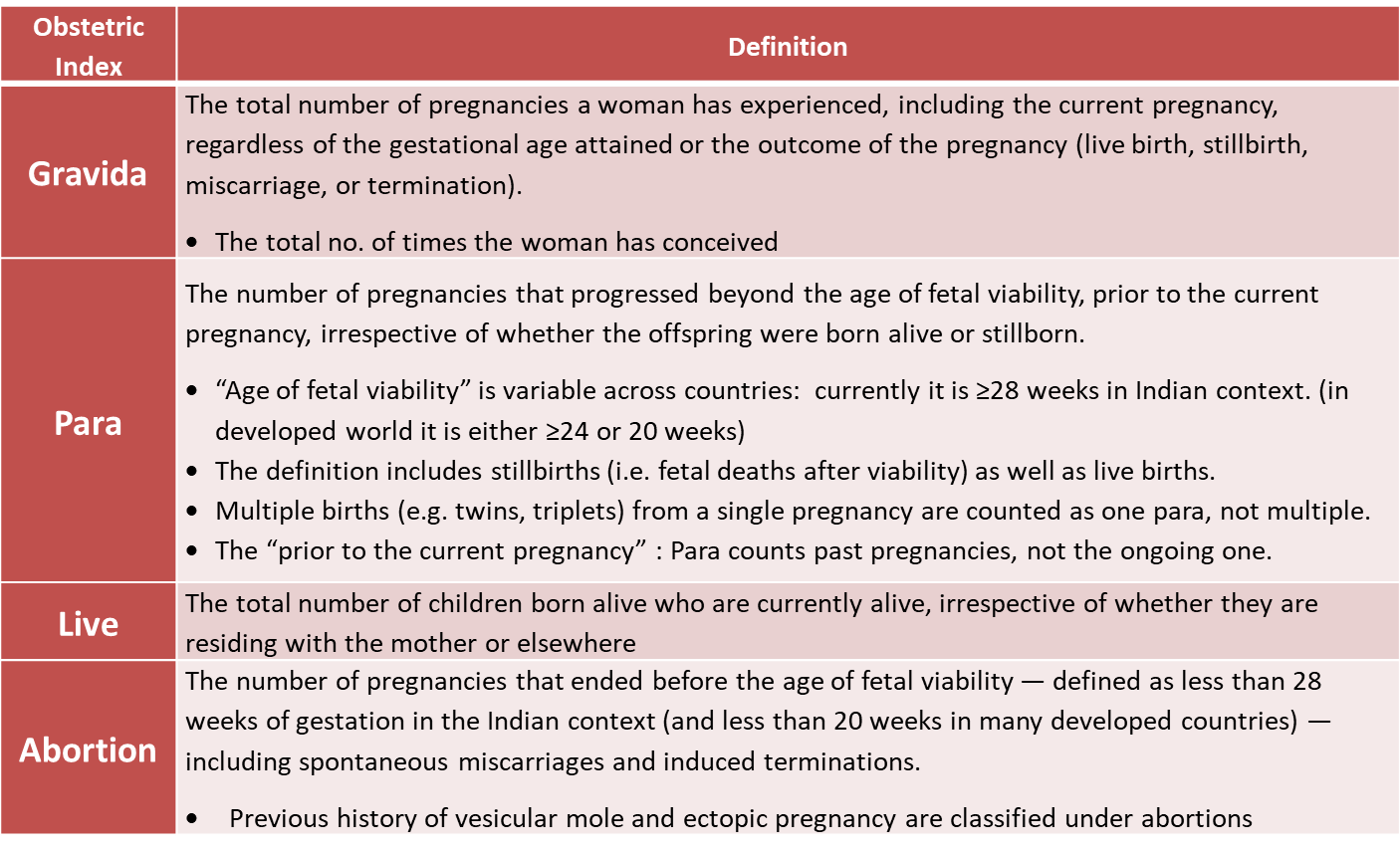The obstetric index, commonly expressed as GPAL, is a standardized system used to summarize a woman’s obstetric history: Gravida (G), Para (P), Live (L) and Abortion (L)
Gravida
The total number of pregnancies a woman has experienced, including the current pregnancy, regardless of the gestational age attained or the outcome of the pregnancy (live birth, stillbirth, miscarriage, or termination).
• The total no. of times the woman has conceived
Para
The number of pregnancies that progressed beyond the age of fetal viability, prior to the current pregnancy, irrespective of whether the offspring were born alive or stillborn
• “Age of fetal viability” is variable across countries: currently it is ≥28 weeks in Indian context. (in developed world it is either ≥24 or 20 weeks)
• The definition includes stillbirths (i.e. fetal deaths after viability) as well as live births.
• Multiple births (e.g. twins, triplets) from a single pregnancy are counted as one para, not multiple.
• The “prior to the current pregnancy”: Para counts past pregnancies, not the ongoing one.
Live
The total number of children born alive who are currently alive, irrespective of whether they are residing with the mother or elsewhere
Abortion
The number of pregnancies that ended before the age of fetal viability — defined as less than 28 weeks of gestation in the Indian context (and less than 20 weeks in many developed countries) — including spontaneous miscarriages and induced terminations.
Previous history of vesicular mole and ectopic pregnancy are classified under abortions
**********************************************************************************
**Viability of Fetus
Viability refers to the stage of fetal development at which the fetus has a reasonable chance of survival outside the uterus, with or without medical assistance.
The threshold varies across regions and — currently (2025) in India it is considered 28 weeks of gestation
In many developed countries it may be 20–22 weeks, depending on neonatal intensive care capabilities.
However, there is advocacy to reduce the age of fetal viability to 24 weeks in India too,
As modern neonatal units in India demonstrate the ability to support the survival of extremely preterm infants
• Born at or after 24 weeks of gestation,
• With improving outcomes due to advances in neonatal intensive care and technology.
Previous history of vesicular mole and ectopic pregnancy are medically and obstetrically classified under abortions because they represent pregnancy losses before fetal viability requiring termination or intervention
References
• Dutta DC. Textbook of Obstetrics. 9th ed. New Delhi: Jaypee Brothers Medical Publishers; 2023. p. 3
• Padubidri VG, Daftary SN. Shaw’s Textbook of Gynaecology. 18th ed. New Delhi: Elsevier; 2022. p. 5.
• Park K. Park’s Textbook of Preventive and Social Medicine. 28th ed. Jabalpur: Bhanot Publishers; 2025. p. 463.
• Babu SA. Clinical Obstetrics and Gynecology. 2nd ed. New Delhi: Wolters Kluwer India Pvt Ltd; 2025.
• Diggikar S, Nagesh K, Batra N. Periviable birth: Legal landscape in Indian jurisprudence. BMJ Paediatr Open. 2025 Jul 30;9(1):e003798. doi: 10.1136/bmjpo-2025-003798. PMID: 40738609; PMCID: PMC12314933.
5-Page ANC History Taking Format: https://ihatepsm.com/blog/5-page-anc-history-taking-format-essential-gui...
Why ANC History Taking Matters?: https://ihatepsm.com/blog/why-anc-history-taking-matters
#Obstetric index (GPAL) in Antenatal Case History: https://ihatepsm.com/blog/obstetric-index-gpal-antenatal-case-history
#Decoding Gravida and Para: Terms in Antenatal History Taking: https://ihatepsm.com/blog/decoding-gravida-and-para-terms-antenatal-hist...
#Duration of Pregnancy: Understanding the Trimesters and Gestational Age Categories: https://ihatepsm.com/blog/duration-pregnancy-understanding-trimesters-an...
#Calculation of Expected Date of Delivery (EDD) and Period of Gestation (POG): https://ihatepsm.com/blog/calculation-expected-date-delivery-edd-and-per...
#Antenatal Care and Case Booking: https://ihatepsm.com/blog/antenatal-care-and-case-booking
#Clinical Significance of Antenatal History Components (Socio-Demographic components): https://ihatepsm.com/blog/clinical-significance-antenatal-history-compon...
Antenatal History Taking: Significance of Clinical Components: https://ihatepsm.com/blog/antenatal-history-taking-significance-clinical...
Trimester-wise History Taking in Antenatal Care: FIRST Trimester: https://ihatepsm.com/blog/trimester-wise-history-taking-antenatal-care-f...
Trimester-wise History Taking in Antenatal Care: SECOND Trimester: https://ihatepsm.com/blog/trimester-wise-history-taking-antenatal-care-s...
Trimester-wise History Taking in Antenatal Care: THIRD Trimester: https://ihatepsm.com/blog/trimester-wise-history-taking-antenatal-care-t...
Trimester-wise History Taking in Antenatal Care: A Comprehensive Guide (all 3 trimesters): https://ihatepsm.com/blog/trimester-wise-history-taking-antenatal-care-c...
Components of Birth Preparedness and Complication Readiness (BPCR): https://ihatepsm.com/blog/components-birth-preparedness-and-complication...
BPCR in brief: https://ihatepsm.com/blog/%E2%80%98birth-preparedness-and-complication-r...
Specific Health Protection during Antenatal Visits: https://ihatepsm.com/blog/specific-health-protection-during-antenatal-vi...
